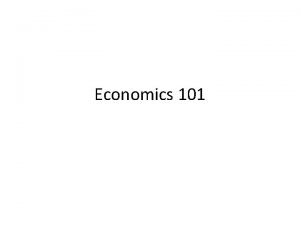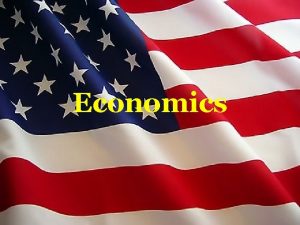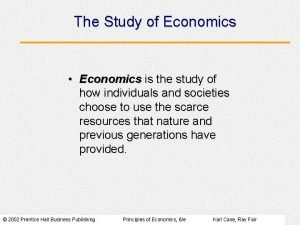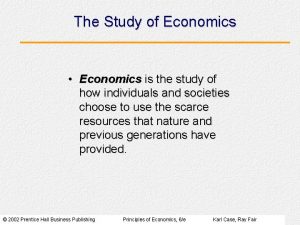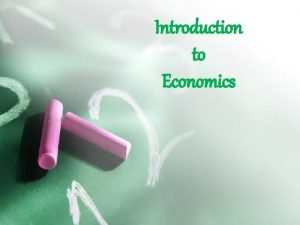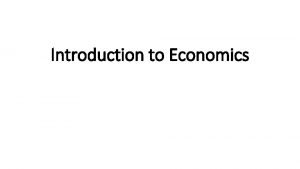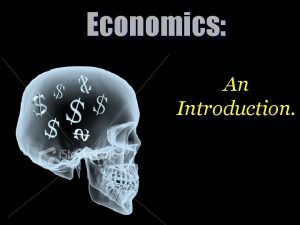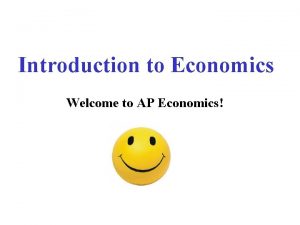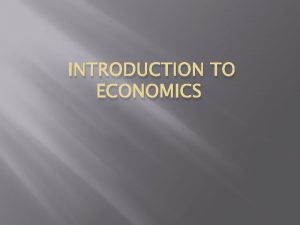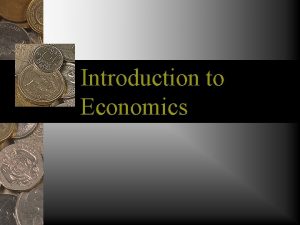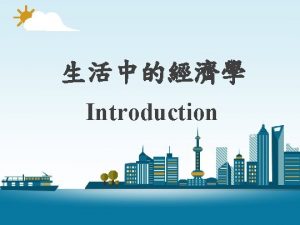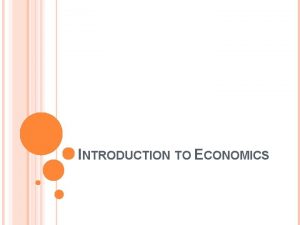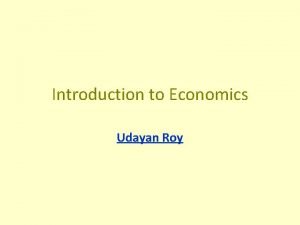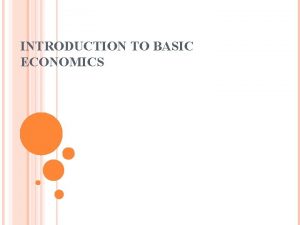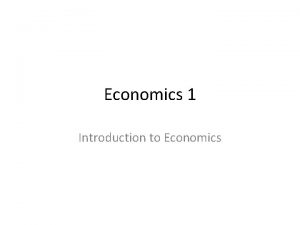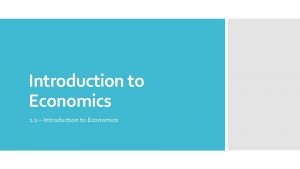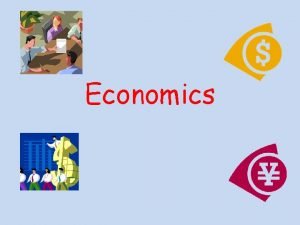Introduction to Economics Economics The study of how



























- Slides: 27

Introduction to Economics

Economics: The study of how individual and groups make choices about how to allocate (use) scare resource to fill their needs and wants. Economics examines how people…. Allocate: Set aside/save resources for a special purpose Make Choices: Determining costs and benefits when a choice is made.

What makes Econ difficult for some students? The words Econ involves many new terms (and maybe even some old terms) with new meanings. Thus, sometimes it is almost seems like a foreign language course. Examples: marginal cost/benefits, opportunity cost, utility,

What makes Econ difficult for some students? The graphs A picture might be “worth a thousand words”, but understanding graphs and being able to interpret economic meanings from those graphs can be difficult for some students.

Understanding Economics • To help develop a stronger understanding of the concepts we discuss in class, try to think of how these ideas can be applied to your everyday life experiences.

Scarcity and the Science of Economics

Types of Economic Resources 1. Land: Natural resources 2. Labor: Work people do 3. Capital *Physical Capital: Physical objects used to create a product *Financial Capital: Money *Human Capital: Knowledge, education, attitudes of labor force.

The Conflict with the Allocation of Economic Resources LAND LABOR CAPITAL Limited Resources BUT Unlimited Wants What is the result?

The result is………. SCARCITY Due to limited resources we are unable to produce everything that everyone needs or wants. *Need: Food, water, shelter needed for survival. *Want: Anything extra beyond needs.

Because the concept of SCARCITY is so key to the understanding of the Economics it is often referred to as …………. . the “fundamental economic problem”. Because of SCARCITY, humans must choose which economic units to produce with the land, labor and capital they have available.

Types of Economic Units Goods: Physical items that can be traded. Example: Services: Non material item that can be traded Examples:

Choice in Economics is called Opportunity Cost: The next best thing that is given up when a choice is made. Example: The opportunity cost of going to class is……sleep? …. work? …. etc

Making‘Good’ Economic Choices When making good economic decisions we need to consider opportunity cost, but we also must think marginally…. Is there a cost or is there a benefit from doing just a little bit more of something. In Economics we call these marginal benefits (MB) and marginal costs (MC) Examples of marginal benefits of more production…. More profit, more revenue, more safety, more health, more satisfaction, less risk, less cost Marginal costs………. opposite of above

An “Economic” Look at an Individual Choice • One activity = ‘A’ Do A if MBA > MCA • Two activities = ‘A’ and ‘B’: a) Can’t do both = ‘Mutually Exclusive’ Look at marginal net benefit of each => (MBA – MCA) vs (MBB - MCB) b) CAN do some of both Look at MB/MC ratio of each Do more A if its MB/MC ratio is greater Do more B if its MB/MC ratio is greater Note: ‘Bad’ choices are often made because………. . 1) MC were under estimated and/or 2) MB were over estimated

Analyzing Marginal Costs and Marginal Benefits in the Game of Monopoly

Let’s Apply More Economic Concepts to Your Game of Monopoly In the game of Monopoly, what would be and example of…… • Land? • Labor? • Capital? • Scarcity? • Opportunity cost?

Branches of Economics • Microeconomics: The study of the economic behavior of individual consumers, firms, or markets. • Macroeconomics: The study of the economic workings and behavior of national or international economies as a whole.

Production Possibilities Curve (PPC) • Graphic way to show to illustrate three important economic concepts—scarcity, choice and opportunity cost. • Stereotypical graph are “guns” (military goods) and “butter” (domestic goods) or schmoos and widgets.

The Production Possibilities Graph

Things Shown on Graph Opportunity Cost: Cost When you gain butter you give up guns Efficiency: Efficiency Edge of graph (points B, D, C) all illustrate efficiency with resources fully employed. Inefficiency: Inefficiency Point A illustrates A situation where resources are underutilized Maximum Production: Production can’t go beyond edge to point X

More Things Shown on Graph Specialization: Specialization Graph is curved/concave because people in some jobs are not good at them therefore illustrating an increasing opportunity cost. Example: At max gun production some non-factory working farmers are making guns poorly.

More Things Shown on Graph • Point D is not always perfect, it depends on your needs. Example: If you were in war do you want to make as much domestic stuff.

The effect of economic growth is shown here. Such growth, made possible by having more resources or increased productivity, causes the production possibilities frontier to move outward making production at point X possible.

What Causes Economic Growth? • Increase in productivity– productivity a more efficient use of resources—no waste. • Investment in human capital– capital a more highly trained and educated workforce • Labor specialization– specialization everyone has a special task that they perform • Economic interdependence– interdependence increased reliance on exportation of goods/services

The PPC and Economic Thinking Cost/Benefits Analysis: Using economic logic to make decisions. Typically weigh the costs and benefits (including opportunity costs) when making a decision Example: Marijuana legalization– what are the costs to its legalization? What would be the benefits?

PPC Review

The study of economic activity has four main purposes: DESCRIBE –Allows us to know what the world is like: (inflation rates, unemployment rates, stock market health etc. . . ) ANALYZE –Analyzes what we describe: what impact is inflation and unemployment having on the economy etc. . . EXPLAIN –Communicates knowledge to others so as to address economics issues and problem: What can Congress do to help inflation and unemployment? PREDICT -Helps us to look at the future with different courses of action: How would a lowering interest rates affect inflation and unemployment?
 Hình ảnh bộ gõ cơ thể búng tay
Hình ảnh bộ gõ cơ thể búng tay Lp html
Lp html Bổ thể
Bổ thể Tỉ lệ cơ thể trẻ em
Tỉ lệ cơ thể trẻ em Chó sói
Chó sói Tư thế worm breton là gì
Tư thế worm breton là gì Hát lên người ơi
Hát lên người ơi Môn thể thao bắt đầu bằng chữ đua
Môn thể thao bắt đầu bằng chữ đua Thế nào là hệ số cao nhất
Thế nào là hệ số cao nhất Các châu lục và đại dương trên thế giới
Các châu lục và đại dương trên thế giới Cong thức tính động năng
Cong thức tính động năng Trời xanh đây là của chúng ta thể thơ
Trời xanh đây là của chúng ta thể thơ Cách giải mật thư tọa độ
Cách giải mật thư tọa độ 101012 bằng
101012 bằng Phản ứng thế ankan
Phản ứng thế ankan Các châu lục và đại dương trên thế giới
Các châu lục và đại dương trên thế giới Thơ thất ngôn tứ tuyệt đường luật
Thơ thất ngôn tứ tuyệt đường luật Quá trình desamine hóa có thể tạo ra
Quá trình desamine hóa có thể tạo ra Một số thể thơ truyền thống
Một số thể thơ truyền thống Cái miệng nó xinh thế
Cái miệng nó xinh thế Vẽ hình chiếu vuông góc của vật thể sau
Vẽ hình chiếu vuông góc của vật thể sau Thế nào là sự mỏi cơ
Thế nào là sự mỏi cơ đặc điểm cơ thể của người tối cổ
đặc điểm cơ thể của người tối cổ Thế nào là giọng cùng tên?
Thế nào là giọng cùng tên? Vẽ hình chiếu đứng bằng cạnh của vật thể
Vẽ hình chiếu đứng bằng cạnh của vật thể Vẽ hình chiếu vuông góc của vật thể sau
Vẽ hình chiếu vuông góc của vật thể sau Thẻ vin
Thẻ vin đại từ thay thế
đại từ thay thế






























